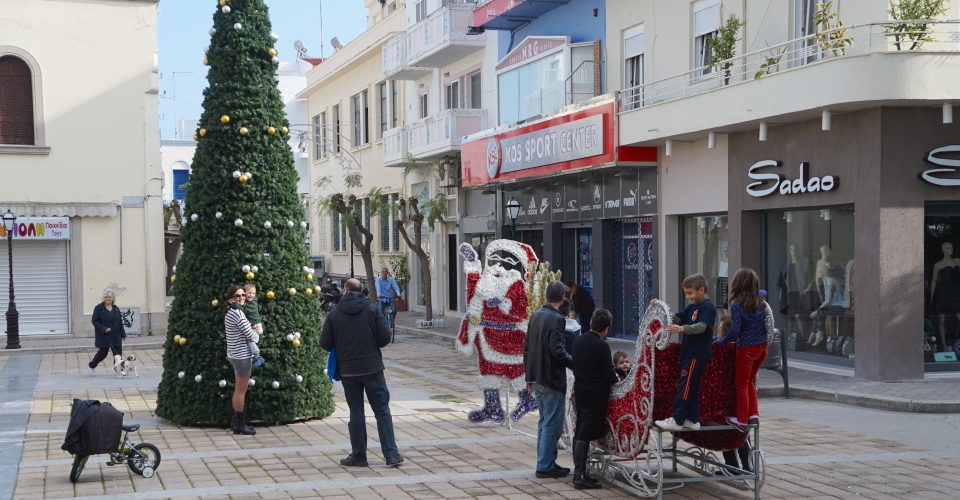It’s December 6, and we are on the island of Kos in Greece. The stores are closed for the celebration of St. Nicholas, the patron saint of sailors, but the sun is out and the cafes are doing a brisk trade. A band approaches and then a procession bearing the icon of St. Nicholas sweeps through the square on its way to the church where the service is being held. The procession passes, and the square is empty again, save for the Christmas tree and Santa Claus display.
It’s December 6, and we are on the island of Kos in Greece. The stores are closed for the celebration of St. Nicholas, the patron saint of sailors, but the sun is out and the cafes are doing a brisk trade. A band approaches and then a procession bearing the icon of St. Nicholas sweeps through the square on its way to the church where the service is being held. The procession passes, and the square is empty again, save for the Christmas tree and Santa Claus display.
The Procession of St Nicholas: The procession carrying the icon of St Nicholas to the church.
After the procession, the square is empty save for the Christmas tree and Santa Claus display.
The mythology of St. Nicholas has been transformed by broken telephone into the mythology of Santa Claus.
There, in a brief flash, we saw the beginning and end of Christianity: the transformation of St Nicholas, via Sinter Klaas and Saint Nick, into Santa Claus – the patron saint of consumers. The mythology of St. Nicholas, he who resurrected three children who had been pickled by a butcher, has been transformed by broken telephone into the mythology of Santa Claus, he who can span the globe in a single night giving gifts to all. It is faith corrupted by greed and commercialism, but as we have found it is more an extrapolation than an abomination. Santa Claus is little more than companies (starting with Coca Cola in 1931) trying to get a piece of the action.
The Church of St. Nicholas at night.
We’ve been to church more times in the last three months than I have in my entire adult life. Every town in France, Italy and Greece has a church, cathedral or duomo. Add in the monasteries perched on remote promontories, and hardly a day has passed without the chance to see icons, frescoes and architectural wonders. We’ve seen small, intimate churches and we’ve stood in awe of the big ones: Notre Dame in Paris, Mont St. Michel, the duomos of Milan and Florence, and St. Peter’s Basilica in Rome. So many of the world’s greatest buildings have been built with contributions from the impoverished pious and donations from the rich in exchange for indulgences. As a result, great buildings now house great wealth.
The church has always had an uneasy relationship with wealth. Jesus overturned the tables of the money lenders and championed the poor, and yet, as we walked through the Vatican museum in Rome we were faced with an overwhelming and unending display of wealth. The Catholic Church is one of the richest institutions in the world. It spends millions annually on humanitarian causes, but at the same time it has amassed a fortune in art and stocks and has an estimated annual budget of around $170-billion.
Standing in St. Peter’s Square for the Pope’s address, you wouldn’t think that formal religion is in decline, but it is. In Canada, a 2013 study by the Pew Foundation found a significant decline in church attendance for both the Protestant and Catholic churches between 1971 and 2011. Even more significantly, the percentage of people declaring no religious affiliation rose from 4 to 24 per cent.
St Peter’s Basilica at night.
This does not mean that those of us with no religious affiliation have turned our backs on spirituality. If anything, as we turn away from the mythology of formal religion the desire for spiritual connection remains strong. At the same time, churches are redefining their relationships with parishioners, faith-based groups are at the forefront of environmentalism and civil rights, and even Pope Francis has urged Catholics to become more active in protecting Creation.
There are parallels between religion and climate change. We have wasted much time trying to get non-believers to believe, instead of focusing on common bonds.
There is still much violence left in this world, but as we make our way up the west coast of Turkey toward Istanbul, you wouldn’t believe it possible. The ezan, or call to prayer, is piped out of minaret loudspeakers five times a day with no discernable change in bustle of the streets. The call is musical, an artistic expression of scripture, and the spirit of Islam surrounds us. As one person told us, talking about the fighting and fanaticism in Syria and southern Turkey, the true spirit of Islam is peace and compassion.
At its worst, religion is tribalism and power; at its best it is spirituality and compassion. There are parallels, strangely enough, between religion and climate change. We have wasted much time trying to get non-believers to believe, instead of focusing on common bonds and improving the human condition.
Faith, at its best, is a socratic dialogue that challenges us to question our motives and action, and to change them to match our values. Perhaps this will be a positive result of the transition from mindless dogma to mindful spirituality.
A minaret above the town of Pamukkale in Turkey.
We will spend Christmas in Istanbul this year. My daughter is determined that Christmas will not pass her by, and she has already planned how we will decorate our apartment with paper snowflakes, a cardboard Christmas tree, and stapled paper stockings. On Christmas morning, there will be a Turkish mandarin orange in the bottom of each stocking, a modern tradition symbolic of the myth of St. Nicholas who would save young girls from being sold into slavery by providing their parents with a marriage dowry. His unorthodox method was to toss gold balls or bags of coins into stockings that had been left by the fire to dry.
If our Christmas will have gifts and rituals, they will eschew the overt consumerism of Santa and emphasize the underlying spirituality: peace on Earth, goodwill to all and respect for all creation. We feel blessed, in so many ways, and we value the gifts that life has given us.
May the true spirit of Christmas live on.
Photos by Chris Winter.
The former executive director of the Conservation Council of Ontario, Chris has started a new initiative to help Canada transition to a sustainable future by “living better with less,” Canada Conserves. After 30 years in the environmental movement, Chris Winter is on a well-deserved round-the-world sabbatical with his family. Along the way, Chris will be sharing examples of how other countries are dealing with climate change, resource scarcity and economic turmoil. Follow him on Twitter or Facebook. You can also follow the family’s Hello Cool World tour blog.













